英语专业本科毕业论文格式
英语专业本科毕业论文文本格式
一、论文文本结构
1. 封面(由学校统一制作)
2. 论文英文扉页(见模版及模版说明)
3. 论文中文扉页(见模版及模版说明)
4. 致谢(可选项)
5. 毕业论文英文摘要
6. 毕业论文中文摘要 7. 毕业论文英文目录
8. 毕业论文正文 9. 注释(可选项)
10. 参考文献
11. 附录(可选项)
二、论文打印规范
1. 使用A4纸,单面打印。
2. 页边距:上边距3.6厘米,下边距2.5厘米,左边距2.8厘米,右边距2.5厘米。
3. 装订线:0厘米。
4. 距边界:页眉2.7厘米,页脚
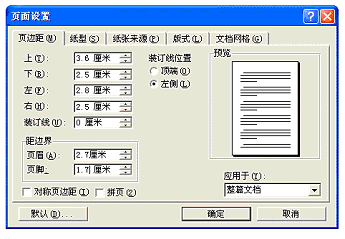
1.7厘米。 如下图所示:
5. 页眉内容:统一为“XX大学XXXX届本科生毕业论文”,使用宋体小五号、居中,(如: 1
XX大学2008届本科生毕业论文)。
6. 页码:选用阿拉伯数字,页面底端居中。第1页为正文第一章的第一页。目录页和摘
要页不标页码和页眉。
三、论文各部分具体格式及要求
1.摘要 ● 摘要内容英文采用Times New Roman,12磅,中文采用宋体,小四号;1.5倍行距。
段落首行缩进4个英文字符或2个汉字字符。
● 长度:英文约为150词。中文摘要内容要与英文摘要内容一致。英文、中文摘要各
占一页。
● 英文“ABSTRACT”一词字母大写,中文“摘 要”之间空两格、加粗、居中,并与内
容文字之间空一行(见图1.1 和图1.2)。 ● 中英文摘要均要求有能反映论文主要内容的关键词2—4个。“Key words:” 及“
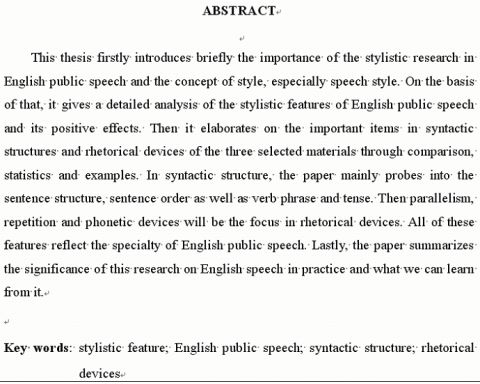
关
键词:”字样须加粗,顶格。各关键词之间有分号及一个空格,移行后须与第一个关键词的首字母对齐,英文采用Times New Roman,12磅,中文采用宋体小四号。 图1.1
2
图
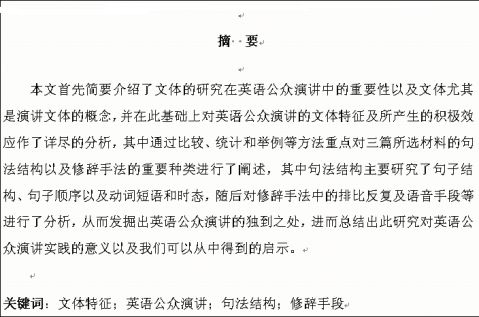
1.2
2.目录页 ● 目录页另页编排,置于摘要页的后面。一级标题加粗,序号采用阿拉伯数字,数字后面加一圆点,如1.、2.、3.等。二级标题及二级以下标题使用阿拉伯数字编排序号,如3.1、3.1.1 等。 ● 目录中的各级标题及页码均须与正文中的标题及页码一致。左侧必须逐级缩进,每级缩进1个汉字字符或2个英文字符。最多可列三级。行距为1.5倍,目录内容字体采用Times New Roman 12磅。“CONTENTS”一词字母大写、加粗、居中,并与目录内容文字之间空一行(见图2.1)。
3
图
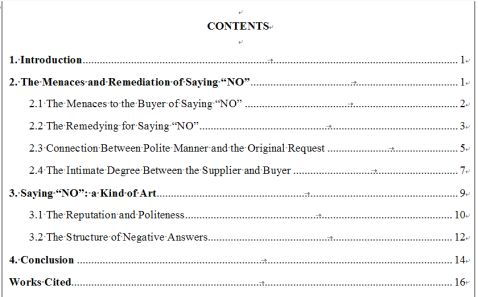
2.1
3.正文 ● 毕业论文要文字通顺、思路清晰、内容充实,并有一定的独立见解。论文字数不少于4800英语单词。 ● 各级标题长度一般不超过一行,各级标题的语法结构应一致。第一个词的首字母必须大写,其余每一个词的首字母,除了冠词、并列连词和4个字母及以下的介词外也都必须大写。使用Times New Roman 12 磅,加粗,行距为1.5倍。
● 仅一级标题居中、加粗并与上一行文字之间空一行。
● 二级及以下各级标题左对齐。
● 正文使用两端对齐方式,1.5倍行距。英文字体使用Times New Roman 12磅,中文使用宋体小四号。
● 段落首行须缩进2个汉字字符或4个英文字符。
● 引语段(中文100字以上,英文50词以上,诗2行以上)要另起一行,不加引号,1.5倍行距,整个引语段左缩进4个汉字字符或8个英文字符;如引语段超过两段,则每段首行须再缩进2个汉字字符或4个英文字符。
4.引文及夹注格式
4
● 引文字体、字号与正文相同,使用括号夹注的方法(一般不使用脚注或者尾注)。夹注中的“作者姓/名”处理方法要根据引文所依据的文献,中文作者用其汉字姓名,英文作者用其姓。正文中括号夹注放在句末标点以内,但不得放在引文的引号以内(见图4.1)。
● 引文原文如被更改,用方括号 “[ ]” 标示,如被省略用省略号 “…” 标示,中文引文应提供英文译文,并将译文置于括号内。
● 双引号表示直接引语,单引号只用来标注引语中的引语。
● 引语段的括号夹注应放在句末的标点以外(见图4.2)。
● 夹注可采用以下几种形式:
例1:
Jan Harold Brunvand, in an essay on urban legends, states: “some individuals [who retell urban legends] make a point of learning every rumor or tale” (1999: 78).
例2:
In an essay on urban legends, Jan Harold Brunvand notes that “some individuals make a point of learning every recent rumor or tale ... and in a short time a lively exchange of details occurs” (1999: 78).
例3:
This may go some way towards explaining learners? foreign-soundingness since, as was pointed by Crystal and Davy (1975), vagueness is an important feature of conversation (Crismore et al. 1993: 89).
例4:
According to Lewis (2001: 255-260), four fundamental types of lexical chunks are identified: 例5:
Wei Naixing (2002) and Neselhauf (2003) hold that combination of words falls into three major classes: free combination, collocation and idiom.
例6:
Ravitch argues that high schools are pressured to act as “social service centers, and they don?t do that well” (qtd. in Weisman 2000: 259).
例7:
5
Human beings have been described as “symbol-using animals” (Burke 1998: 3). 例8:
Wordsworth stated that Romantic poetry was marked by a “spontaneous overflow of powerful feelings” (1999: 263).
例9:
Romantic poetry is characterized by the “spontaneous overflow of powerful feelings” (Wordsworth 1999: 263).
Wordsworth extensively explored the role of emotion in the creative process (263).
例10:
Marx and Engels described human history as marked by class struggles (1960: 79; ch. 1). 例11:
Although some medical ethicists claim that cloning will lead to designer children (R. Miller 2001: 12), others note that the advantages for medical research outweigh this consideration (A. Miller 2002: 46).
例13:
...as has been discussed elsewhere (Burke 2000: 3; Dewey 2001: 21).
例14:
…when they are not familiar with the culture background. It means that the input should be the comprehensible input (李文彬2006).
图4.1:括号夹注在正文中的使用方法

图4.2:括号标注在引语段中的使用方法
6
* 脚注的使用
● 脚注只在下列两种情况中考虑使用:(1)提供有一定重要性、但写入正文会妨碍文本条理和逻辑的解释性信息;(2)提供因篇幅过长不宜使用括号夹注注明的文献出处信息。脚注应该使用阿拉伯数字编号上标,每页重新开始。
5. 参考文献
具体格式请参阅上海外语教育出版社出版的《MLA科研论文写作规范》(第五版)。 ● 参考文献需另起一页,置于正文后,采用12磅Times New Roman字体,1.5倍行距。 ● 英文“Works Cited”首字母大写、加粗、居中。
● 参考文献应是文中所有引文的出处和所依据的文献,所列条目数不少于十条,其中中文献数不多于三条,网络文献不多于三条。
● 网络文献应注明文献发表日期、下载日期和网页的网址(注:其中中文文献日期写法为“年-月-日”)。
● 文献条目按作者姓氏(中文姓氏按其拼音)的字母顺序排列,中外文献分别排列。外文文献在前,中文文献在后。同一作者多篇文献按文献题目的字母顺序排列。外文书名以斜体书写;外文论文篇名不用斜体,但置于引号内。书名和论文篇名第一个词的首字母必须大写,其余每一个词的首字母,除了冠词、并列连词和4

个字母及以下的介词外也都必须大写。每条顶格写,移行时悬挂缩进2.5个汉字字符或5个英文字符。
● 参考文献格式具体说明如下:(除书名号外的标点符号均用 Times New Roman 字体)

7
1. 独著
Lastname, Firstname. Title of Book. Place of Publication: Publisher, Year of
Publication.
姓名. 《书名》. 出版地: 出版社, 出版年代.
2. 两至三名作者
First author?s Lastname, Firstname, and subsequent author?s Firstname Lastname.
Title of Book. Place of Publication: Publisher, Year of Publication.
姓名, 姓名, 姓名. 《书名》. 出版地: 出版社, 出版年代.
3. 四名或以上作者
Lastname, Firstname, et al. Title of Book. Place of Publication: Publisher, Year of
Publication.
姓名, 等. 《书名》. 出版地: 出版社, 出版年代.
4. 机构作者
The agency?s name. Title of Book. Place of Publication: Publisher, Year of
Publication.
机构名称. 《书名》. 出版地: 出版社, 出版年代.
5. 匿名作者
Title of Book. Place of Publication: Publisher, Year of Publication.
《书名》. 出版地: 出版社, 出版年代.
6. 同一作者两本以上著作
以书名第一个主要单词的首字母顺序排列先后,作者的姓名放在第一条文献条目前,第二条文献条目前用三个连字号。
Lastname, Firstname. Title of the First Book. Place of Publication: Publisher, Year of
Publication.
---. Title of the Second Book. Place of Publication: Publisher, Year of Publication. 姓名. 《A书名》. 出版地: 出版社, 出版年代.
---. 《B书名》. 出版地: 出版社, 出版年代.
7. 编著
1) 一名编者:
8
Lastname, Firstname, ed. Title of Book. Place of Publication: Publisher, Year of
Publication.
姓名, 编. 《书名》. 出版地: 出版社, 出版年.
2) 两名编者:
First author?s Last name, Firstname, and subsequent author?s Firstname Lastname,
eds. Title of Book. Place of Publication: Publisher, Year of Publication.
姓名, 姓名, 编. 《书名》. 出版地: 出版社, 出版年代.
3) 三名以上的编者:
First author?s Last name, Firstname, et al., eds. Title of Book. Place of Publication:
Publisher, Year of Publication.
姓名, 等编. 《书名》. 出版地: 出版社, 出版年代.
8. 译著
Source text author?s Last name, Firstname. Title of Book. Trans. The translator?s
Firstname Last name. Place of Publication: Publisher, Year of Publication. 原作者姓名. 《书名》. 译者姓名, 译. 出版地: 出版社, 出版年.
9. 再版著作
Last name, Firstname. Title of Book. The number of the edition ed. Place of
Publication: Publisher, Year of Publication.
姓名. 《书名》. 第几版. 出版地: 出版社, 出版年代.
10. 论文集中的文章
The article author?s Last name, Firstname. “Title of Book.” Title of the Anthology or
Collection. Ed. The anthology ediotor?s Firstname Last name. Place of
Publication: Publisher, Year of Publication. Page number(s).
文章作者姓名. “文章标题.” 论文集名称. 论文集编者姓名, 编. 出版地: 出版社,
出版年代. 起止页码.
11. 多卷或多册著作(书名后注明第几册或第几卷.)
Last name, Firstname. Title of Book. the volume number vols. (other information).
Place of Publication: Publisher, Year of Publication.
姓名. 《书名》. 第几卷. (其他信息). 出版地: 出版社, 出版年代.
9
12. 前言,后记
The author?s Last name, First name. Introduction /Forewords/ Preface/ Afterwords.
By The same author?s Last name. Place of Publication: Publisher, Year of
Publication. Page number.
The author?s Last name, First name. Introduction or Forewords or Preface. By
Different author?s First name Last name. Place of Publication: Publisher, Year of Publication. Page number.
前言作者姓名. 引言/前言/序/后记. 《书名》. 书目作者姓名. 出版地: 出版社, 出
版年代. 起止页码.
13. 期刊文章
The article author?s Last name, First name. “Title of the Article.” Title of the
Magazine Number of the volume. Number of the issue (Year of Publication): page number(s).
文章作者姓名. “文章标题.” 《杂志名称》 卷号. 期号 (出版年代): 起止页码.
14. 周刊或双周刊文章
The article author?s Last name, First name. “Title of the Article.” Title of the
Magazine Date Month Year of Publication: page number(s).
文章作者姓名. “文章标题.” 《杂志名称》 出版年月日: 起止页码.
15. 月刊或双月刊文章
The article author?s Last name, First name. “Title of the Article.” Title of the
Magazine Month Year of Publication: page number(s).
文章作者姓名. “文章标题.” 《杂志名称》 出版年月: 起止页码.
16. 报纸文章
The article author?s Last name, First name. “Title of the Article.” Title of the
Newspaper Date Month Year of Publication, Section number, Column number, Page number(s).
文章作者姓名. “文章标题.” 《报纸名称》 出版年月日, 第几版, 第几栏, 页码. 如果作者未知, 版栏信息缺失, 格式为:
“Title of the Article.” Title of the Newspaper Date Month Year of Publication: Page
number(s).
“文章标题.” 报纸名称 出版年月日: 页码.
10
17. 网络著作
The author?s Last name, First name. Title of the Book. Year of Publication. Date
Month Year you accessed the material. < URL/electronic address>.
作者姓名. 《书名》. 出版年代. 检索年-月-日. <详细网址>.
18. 网络文章
The article author?s Last name, First name. “Title of the Article.” Date Month Year
of Publication. Date Month Year you accessed the material. < URL/electronic address>.
作者姓名. “文章名称.” (来源名称). 发表年-月-日. 检索年-月-日. <详细网址>.
19. CD-ROM
The author?s Last name, First name. “Title of the Item.” The name of the CD-ROM.
CD-ROM. Place of Publication: Publisher, Year of Publication. Page number. 作者姓名. “条目标题.” 光盘名称. (其他信息). 出版地: 出版社, 出版年代.
11
例:
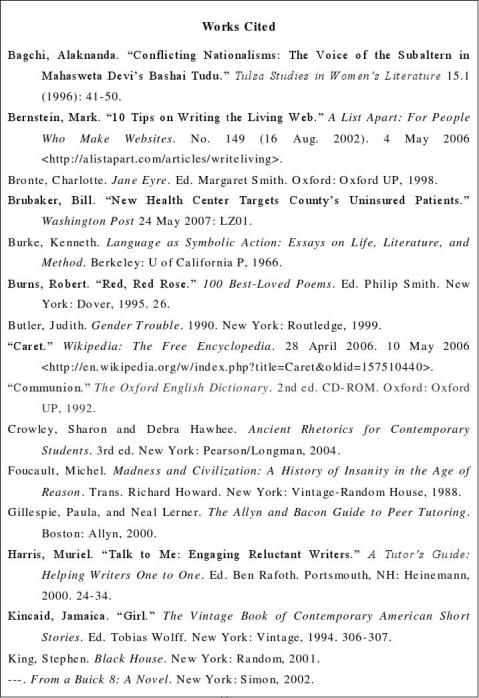
6. 扉页格式
● 具体参见“扉页模版说明”。
● 标题文字使用Times New Roman,24磅, 居中, 第一个词的首字母必须大写,其余每一个词的首字母,除了冠词、并列连词和4个字母及以下的介词外也都必须大写。 13

●
14
-
英语专业本科毕业论文格式排版要求
外国语学院英语专业毕业论文格式要求与样本本格式主要在原英语系毕业论文格式基础之上参阅了外语教学与研究及部分大学外语学院毕业论文格式…
-
英语专业本科毕业论文写作格式模版
海南师范大学本科生毕业论文职前英语教师课堂提问策略的研究姓名张小辉学号20xx0689999专业英语年级20xx级系别英语系完成日…
-
本科毕业论文英语类范文
宁波大学成人教育学院题目毕业论文浅谈翻译里的中西方文化差异及其影响ChinaandWesternculturaldifferenc…
-
英语专业本科毕业论文怎么写
英语专业本科毕业论文怎么写一论文撰写的步骤与方法本科论文的写作一般由选题文献检索与资料整理撰写提纲起草论文教师批改修改定稿等步骤组…
-
英语专业本科毕业论文题目范例
四川外语学院成都学院本科毕业生论文参考题目一论文参考题目一1红字中海丝特白兰不理智的一面TheIrrationalSideofHe…
-
本科毕业论文英文题目及英文摘要撰写指导
本科毕业论文英文题目及英文摘要撰写指导毕业论文是本科生对大学所学知识的总结性作业又是申请学士学位的前提和依据在系统介绍学术论文的英…
-
高等教育自学考试英语专业本科毕业论文撰写说明
高等教育自学考试英语专业本科毕业论文撰写说明一论文撰写的步骤与方法本科论文的写作一般由选题文献检索与资料整理撰写提纲起草论文教师批…
-
本科英语毕业论文题目
本科英语毕业论文题目论文涉及到文学文化翻译语言学广告法律教育教学法经贸商务等方向内容绝对原创论中英习语的文化差别CulturalD…
-
英语专业毕业论文开题报告的写法、论点和论句
在正式撰写毕业之前学生要写出以便指导老师能根据学生对文献的综述和对所选论题的认识确定其可行性开题报告是作者将自己初步选定的题目之内…
-
英语专业本科毕业论文模板_大学毕业论文
英语专业本科毕业论文模板姓名系别外语学院专业英语学号00000000指导教师20xx年5月thesiswritingstandar…
-
英语专业毕业论文范文1
关于论文结构和格式规范的有关问题请认真阅读外国语学院英语本科毕业论文撰写要求同时可查阅MLA格式学位论文写作规范供查询用建议以本范…